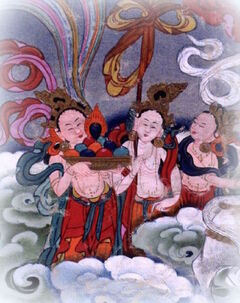Praise Series
English (125) | Deutsch (11) | Español (10) | Français (26) | Português (3) | Italiano (4) | Nederlands (2) | 中文 (4) | བོད་ཡིག (125)
A selection of praises (Skt. stotra; Tib. bstod pa) to various Buddhist deities and prominent masters (arranged according to subject):
Abhidharma Lineage
Akṣobhya
Amitāyus
Avalokiteśvara
by
Lakṣmī
Buddha's Words
Buddhas
Butön Rinchen Drup
Candragomin
Candrakīrti
Chokgyur Dechen Lingpa
Dezhung Tulku Ajam
Drikung Kyobpa Jikten Sumgön
Dudjom Rinpoche
Dzogchen
Fourteenth Dalai Lama
Ga Rabjampa Kunga Yeshe
Gatön Ngawang Lekpa
Gorampa Sonam Senge
Jamyang Gyaltsen
Jamyang Khyentse Wangpo
Jamyang Loter Wangpo
Jigme Lingpa
Kālīdevī
Khenpo Kunzang Palden
Khenpo Tsultrim Lodrö
Kṣitigarbha
Longchen Rabjam
Lords of the Three Families
Machik Labdrön
Mandāravā
Mārīcī
Milarepa
Ngorchen Kunga Zangpo
Niguma
Pakmodrupa Dorje Gyalpo
Patrul Rinpoche
Rogza Sönam Palge
Sachen Kunga Nyingpo
Sacred Places
Sakya Paṇḍita
Śāntarakṣita
Sarasvatī
Smṛtijñānakīrti
Tana Monastery
Tāranātha
Thirty-Five Buddhas
by
Mātṛceṭa
Thönmi Sambhoṭa
Three Great Lotsāwas
Three Jewels
by
Mātṛceṭa
